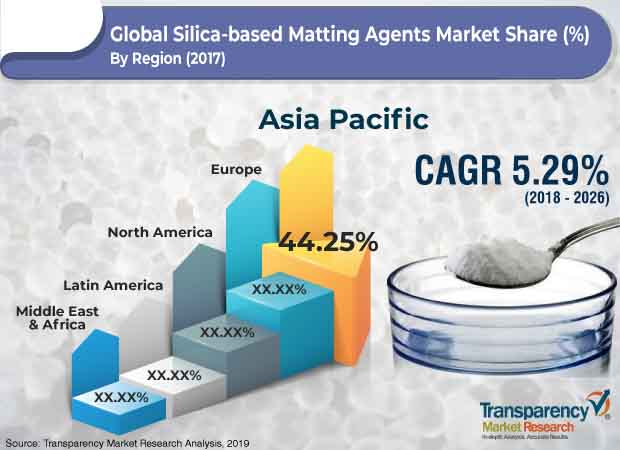
Silica-based Matting Agents Market – Snapshot
Matting agents help control the gloss of the surface on which they are applied. These agents are fine particles that are dispersed in paint and coating formulations in such a way that they scatter the light falling on the surface in a desired, defined manner. This helps achieve matte finish or reduce the gloss of the surface on which they are applied. Silica is a major raw material that is used in the manufacture of matting agents.
Read report Overview-
https://www.transparencymarketresearch.com/silica-based-matting-agents-market.html
Precipitated silica and fumed silica are two major types of processed silica that are employed in the manufacture of matting agents. Silica-based matting agents have high efficiency in terms of matting power. Coatings containing silica-based matting agents are recoatable.
Request Brochure @
https://www.transparencymarketresearch.com/sample/sample.php?flag=B&rep_id=64314
These agents are employed in all coating systems, except powder coatings. There are primarily two types of silica-based matting agents: untreated silica-based matting agents and wax after-treated silica-based matting agents. Both these types are used in various coating applications. Demand for silica-based matting agents has been rising in wood and industrial coating applications.

Based on technology, the global silica-based matting agents market has been segmented into solvent-based, water-based, and others (powder and UV-cured). Water-based silica-based matting agents are eco-friendly and are utilized in paints and coatings applications. These types of silica-based matting agents generate negligible VOC emissions. Therefore, they are referred to as eco-friendly. They have excellent compatibility with water-based resins. The segment is estimated to expand at a rapid pace during the forecast period.
REQUEST FOR COVID19 IMPACT ANALYSIS –
https://www.transparencymarketresearch.com/sample/sample.php?flag=covid19&rep_id=64314
In terms of application, the global silica-based matting agents market has been divided into industrial coatings, wood coatings, architectural coatings, automotive coatings, and others (including leather and textiles). The industrial coatings segment can be further sub-segmented into metals, papers, plastics, printing inks, and others (including glass). Industrial coatings is the dominant segment of the global silica-based matting agents market. Growth in wood coatings and architectural coatings segments is estimated to propel the demand for silica-based matting agents during the forecast period. Rise in consumer preference for low gloss and matt finishes in these applications is driving the demand for matting agents.
Based on region, the global silica-based matting agents market has been classified into North America, Europe, Asia Pacific, Middle East & Africa, and Latin America. Asia Pacific is the major consumer of matting agents in general and silica-based matting agents in particular. This high demand can be ascribed to the presence of a vast paints & coatings industry in the region. Europe is another key consumer of silica-based matting agents in the world. The silica-based matting agents market in Europe is likely to expand at a sluggish pace during the forecast period. In terms of demand, North America also constitutes important share of the global silica-based matting agents market. The market in the region is anticipated to expand at a moderate pace between 2018 and 2026. The market in Latin America and Middle East & Africa is likely to expand at a considerable pace, creating lucrative opportunities during the forecast period. Expansion in construction and infrastructure activities across the globe is fueling the demand for paints and coatings. This, in turn, is augmenting the demand for silica-based matting agents.
The silica-based matting agents market is dominated by large players. It is highly consolidated. Key players operating in the market are Evonik Industries AG, W.R. Grace & Co.-Conn, PPG Industries, Inc., PQ Corporation, The Lubrizol Corporation, Imerys, and Akzo Nobel N.V.





